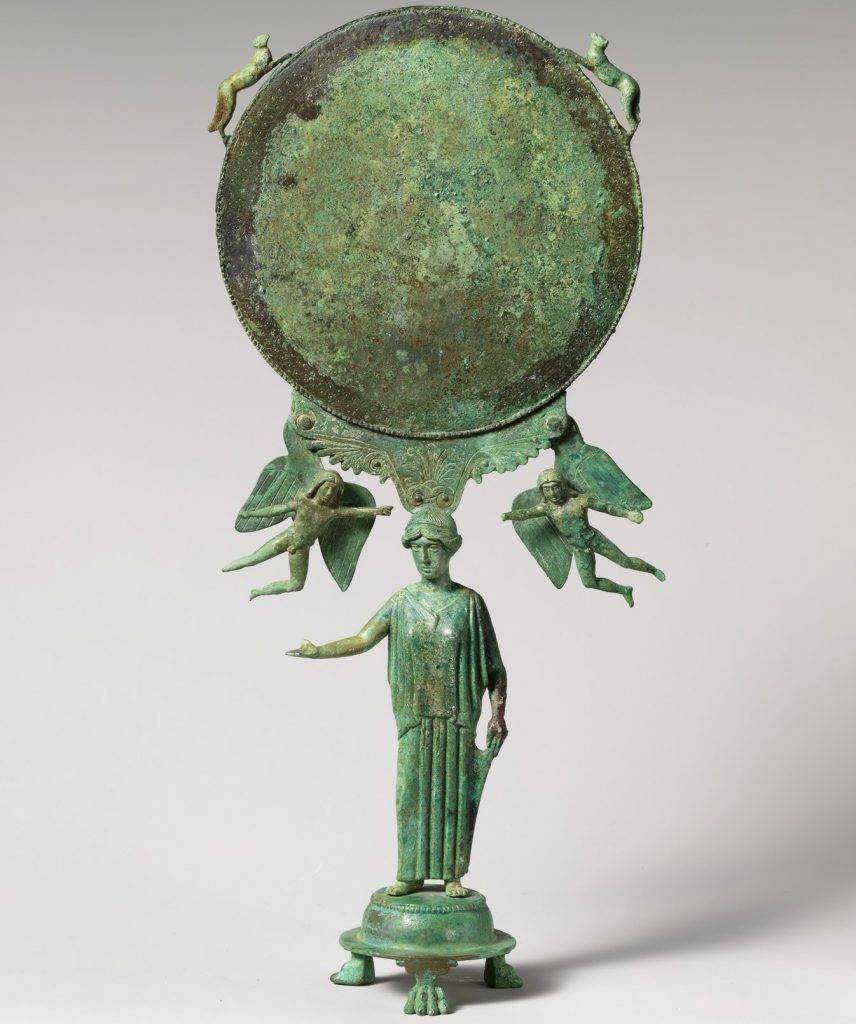What kind of mirrors were used in ancient times?

The question of what kind of mirrors were used in ancient times has long been debated. While some scholars attribute the invention of glass mirrors to Alexander of Aphrodisias in the third century A.D., others point to the residents of Sidon as the originators of glass mirrors. Nevertheless, the use of glass mirrors dates back to ancient times and has been unearthed in archeological digs.
Glass
Ancient cultures have been using glass mirrors to reflect light for thousands of years. The process of producing glass mirrors has evolved greatly over time, with a particular emphasis on the use of different metal alloys. As early as 500 AD, Chinese mirror makers were using silver-mercury amalgams, which was subsequently used in early Renaissance and 16th century Venice. Earlier mirrors were not very clear and exhibited a number of flaws. However, a surge in development during the 13th to 15th centuries brought about a distinctly superior process.
It has long been suspected that ancient societies used glass mirrors, and there are even references to glass mirrors in the Greek and Roman period. However, there is a great debate over when glass mirrors were first created. Some scholars believe that glass mirrors were developed in the third century A.D., but there is no archaeological proof of this.
The invention of the glass mirror was a key step in the evolution of humankind. Originally, they were only used for personal grooming, but as the bourgeoisie gained more wealth and influence, they were also able to make them more widely available. Moreover, bourgeois publications and advertisements endorsed their use for social etiquette and personal grooming. Despite their fragility, mirrors became an integral part of society’s culture.
Metal
Mirrors have long been a staple of civilizations, and the ancients were no exception. They were often made of gold, copper, or tin. Ancient civilizations had an obsession with beauty and attributed mirrors to the god Hephaistos, the Greek god of fire and metal. Some ancient metal mirrors were surprisingly small and were not much larger than a fingernail.
One type of ancient metal mirror was iron pyrite. This type of metal was used by the Incan civilization in the Andean region. It occurs naturally in nodules two inches in diameter. Some of these nodules were split and polished, and some were drilled with holes to be suspended from the ceiling. These mirrors were used for both interior and exterior purposes.
In ancient times, mirrors were used for a variety of purposes, including communication and divination. They were also used as fire starters. Many ancient cultures believed that a dead person’s soul could be seen by the gods through a mirror. Mirrors were also used to protect tombs from thieves and evil spirits.
Mosaic
Mirrors were used in ancient times for various purposes, including personal grooming. In the Roman world, mirrors were common in every town and settlement. During the Dark Ages, mirror-making became less common and seemed to die out altogether, but there are a few surviving artifacts from the time period.
Today, mosaics are a popular craft, with many types of materials and designs. Although mosaics of ancient times were mainly architectural in nature, modern mosaics may be used for decorative purposes in any room of the home. Mosaics are also used to decorate furniture, flower pots, windows, and benches. Mosaics can depict anything from everyday scenes to complex landscapes. They are also ubiquitous in public places, including subway stations and parks. In New York City, for example, there are more than 70 mosaics in the subway station.
Ancient mosaics often used terra-cotta threads as contours. Byzantines also used terra-cotta tesserae for depicting red objects. Ceramic tesserae have a smooth surface, which makes them a good competitor to glass and stone.
Obsidian
Obsidian mirrors were used in the ancient world for a variety of purposes, including divination. These mirrors were called “tezcatl” by the Aztecs and derive from the Aztec word “popolhuia,” which means “to predict.” These mirrors had the ability to reflect images and fates. When obsidian was smoked, it could even reflect speech and music.
The first obsidian mirrors were made from black obsidian, which is extremely rare today. However, they were used by a number of ancient cultures, including the Maya. They were popular among artists, travelers, and landscape connoisseurs. Several examples of these mirrors were made in Mexico, and they are largely found in the Michoacan and Oaxaca valleys.
The material was used in a variety of tools. It was also used to make jewelry. Obsidian was also used by ancient Maya and Aztecs to communicate with spirits. The material has been used as a tool for thousands of years, and the history of obsidian mirrors in Mexico is fascinating.
Although obsidian mirrors were used in ancient times, they were not used in the same way as today. Some Mesoamerican cultures used obsidian mirrors as decorative ornaments in their jewelry. The elites of Mesoamerican society used highly polished obsidian in earrings, earplugs, lip piercings, and other jewellery. Some of these pieces were created by the Tula craftspeople, who were legendary amongst the later Aztecs.
Glass tiles
Glass tiles were used in ancient times as a way to create a variety of designs for floors and walls. The technique, known as opus sectile, was developed by the Hellenistic people and was also used by the Romans for wall design. By the 4th century CE, glass tiles became more common in private homes.
Ancient Egyptians, Greeks, and Romans used glass tiles to create mosaics. Artists in Persia, Syria, and North Africa also used them. Glass tile was used for the first time in Egypt. Most mosaics were made from stone, marble, and glass. In ancient times, glass tiles were used to decorate the floors and walls of a home or temple.
There are three types of glass tiles. Each type has its unique properties. The first type is cast glass, which is created by heating molten glass to around 1,600 degrees Fahrenheit. This process gives the glass tiles their unique appearance and makes them much more durable. Some types of glass tile are colored using iridescent pigments or other processes.
Byzantine and Islamic mosaics were made with different methods. The Byzantine ones were not grouted and were known for their sparkle effect. Islamic mosaics, on the other hand, were usually made from stone and used geometric designs. The tiles were made using a technique called zillij. This technique involves the creation of tiles for a specific artistic project. The finished effect is seamless, and the tiles are often set at a slight angle to the wall.
Obsidian mirrors
One of the oldest mirrors in the archaeological record is made from polished obsidian. These objects were used for grooming purposes and are thought to date back to around 4,000 BCE. The earliest hand mirrors were made from a flat metal disk attached to a handle, but they were not made with glass. The first glass mirrors were made in the third century AD and are made from small metal surfaces with glass coatings.
The British Museum has a large collection of obsidian artefacts. One of them is an obsidian mirror that is about 7.2 inches in diameter and half an inch thick. It resembles the black mirrors found in drawings made by native peoples of the Tepetlaoztoc civilization in Central Mexico.
The obsidian mirror was a popular accessory for the Aztec deity Tezcatlipoca, who ruled the night. His name means’smoking mirror’, and the obsidian mirror was one of his most important accessories. It was believed that the obsidian mirror could reflect images and fates. It could even reflect speech and music.
Silvered-glass
Mirrors have been around since ancient times, but the process of making them has changed over time. Some ancient civilizations used silvered glass. But not everyone liked the look. Mirrors are not the only way to beautify a room. They can be used as tools as well.
Before they became popular, mirrors were used by royalty and aristocrats. However, they did not exist for the general public until 1835, when Justus von Liebig developed a process that allowed mirrors to be mass produced. This method made mirrors more affordable and more widely available.
Mirrors were often made from silver in ancient times, but more modern versions are made from less expensive materials, including gold. The process for making these mirrors has changed over time, but the basics remain the same. The material is more reflective than any other material, and ancient writers describe them as being more beautiful than anything else.
Mirrors are used as a tool for beauty and personal grooming. Mirrors first became popular among the ancient Egyptians, who used polished bronze mirrors to study their appearances. The ancient Greeks and Romans also had mirrors, but they were much smaller than today. These early mirrors had an eyelet and a stand up handle for hanging. Some even had a protective metal cover.
About the Author

I am a writer who does research on the bathroom and researches whether minimalist or modern bathroom equipment and products. I will continue to write to make the time spent in the bathrooms enjoyable.
